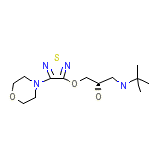Timoptic in Ocudose




Timoptic in Ocudose Brand names, Timoptic in Ocudose Analogs
Timoptic in Ocudose Brand Names Mixture
- Combigan (Brimonidine Tartrate + Timolol Maleate)
- Cosopt -(2%/0.5% Oph Dps) (Dorzolamide Hydrochloride + Timolol Maleate)
- Timolide Tab (Hydrochlorothiazide + Timolol Maleate)
- Timpilo 2 (Pilocarpine Hydrochloride + Timolol Maleate)
- Timpilo 4 (Pilocarpine Hydrochloride + Timolol Maleate)
- Xalacom (Latanoprost + Timolol Maleate)
Timoptic in Ocudose Chemical_Formula
Timoptic in Ocudose RX_link
Timoptic in Ocudose fda sheet
Timoptic in Ocudose msds (material safety sheet)
Timoptic in Ocudose Synthesis Reference
Timoptic in Ocudose Molecular Weight
Timoptic in Ocudose Melting Point
Timoptic in Ocudose H2O Solubility
Timoptic in Ocudose State
Timoptic in Ocudose LogP
Timoptic in Ocudose Dosage Forms
Timoptic in Ocudose Indication
Timoptic in Ocudose Pharmacology
Timoptic in Ocudose Absorption
Timoptic in Ocudose side effects and Toxicity
Timoptic in Ocudose Patient Information
Patients should be instructed to avoid allowing the tip of the dispensing container to contact the eye or surrounding structures. Patients should also be instructed that ocular solutions, if handled improperly, could become contaminated by common bacteria known to cause ocular infections. Serious damage to the eye and subsequent loss of vision may result from using contaminated solutions.
Patients should also be advised that if they have ocular surgery or develop an intercurrent ocular condition (e.g.,trauma or infection), they should immediately seek their physicianís advice concerning the continued use of the present multidose container. Patients should be instructed to invert the closed container and shake once before each use. It is not necessary to shake the container more than once. Patients requiring concomitant topical ophthalmic medications should be instructed to administer these at least 10 minutes before instilling Timolol GFS. Patients with bronchial asthma, a history of bronchial asthma, severe chronic obstructive pulmonary disease, sinus bradycardia, second or third degree atrioventricular block, or cardiac failure should be advised not to take this product. Transient blurred vision or visual disturbance, generally lasting from 30 seconds to 5 minutes, following instillation may impair the ability to perform hazardous tasks such as operating machinery or driving a motor vehicle.














